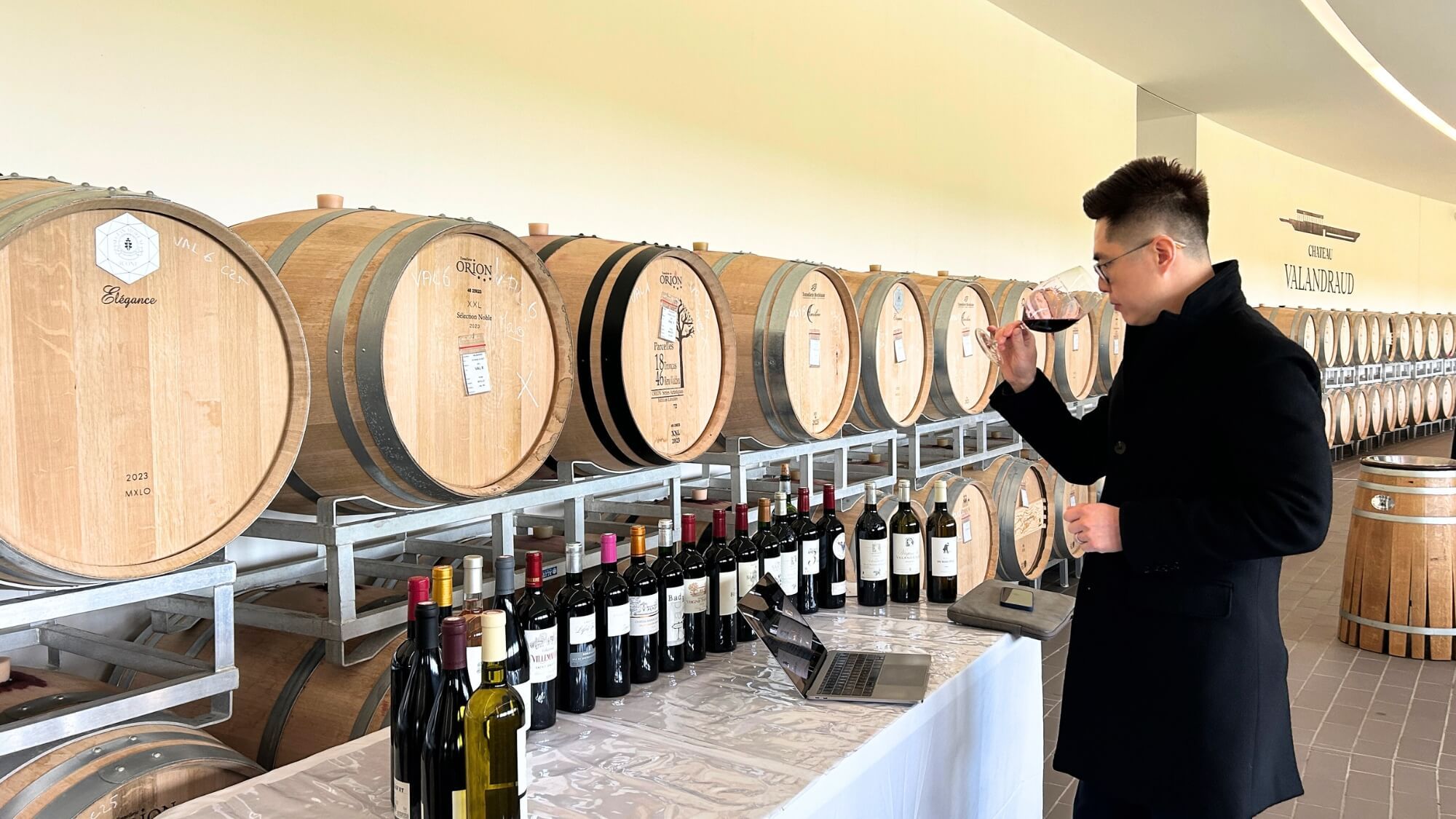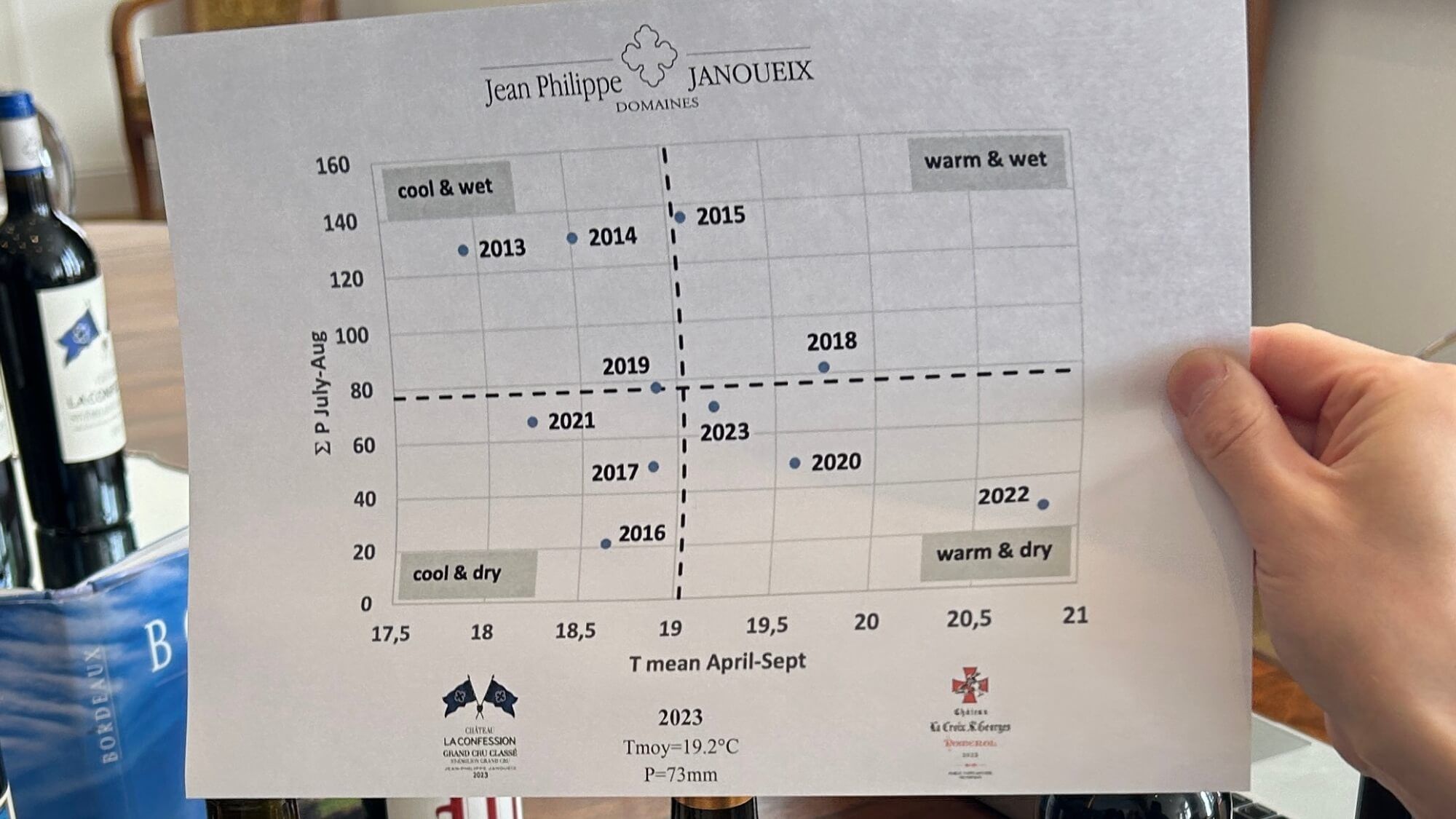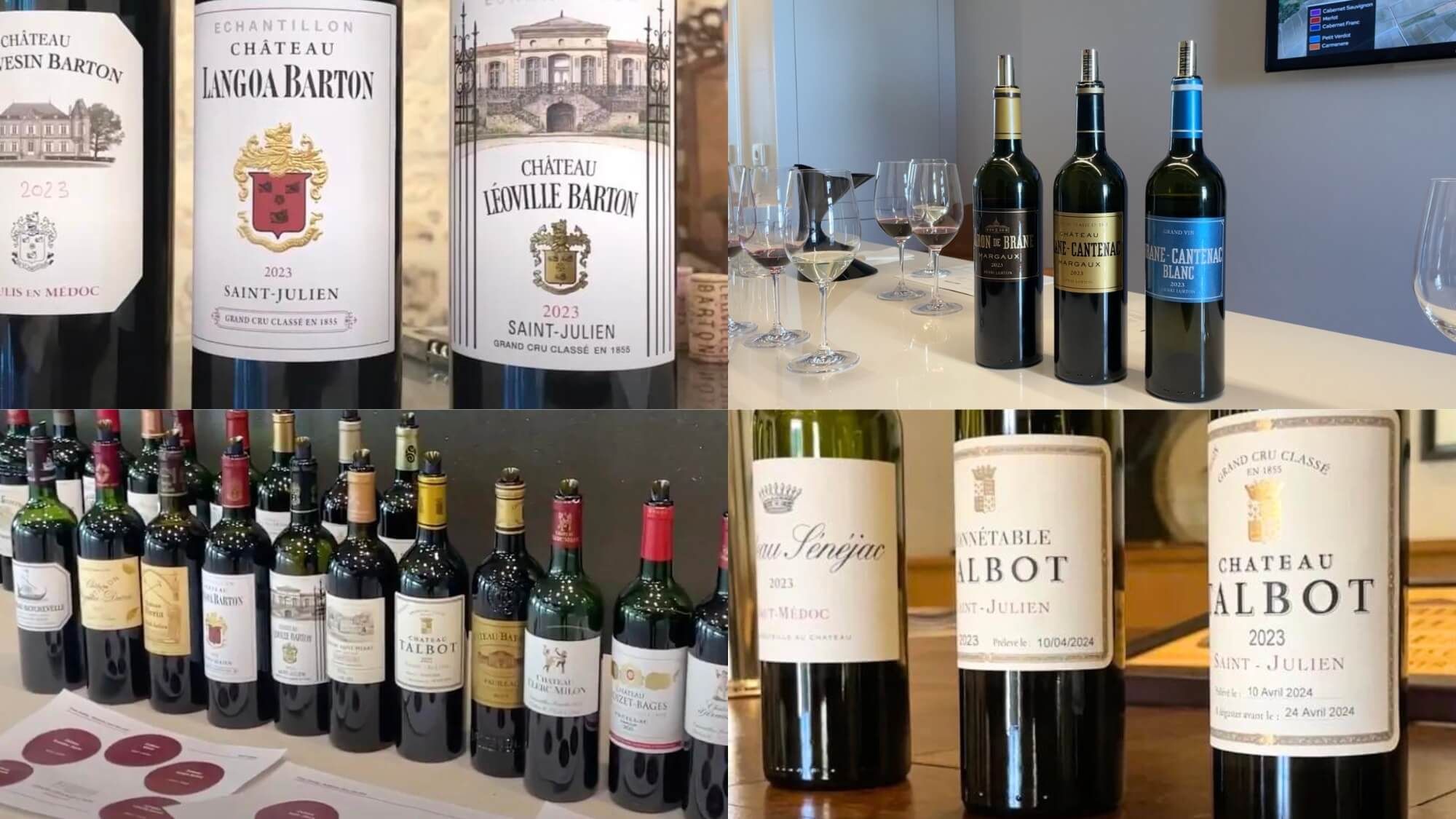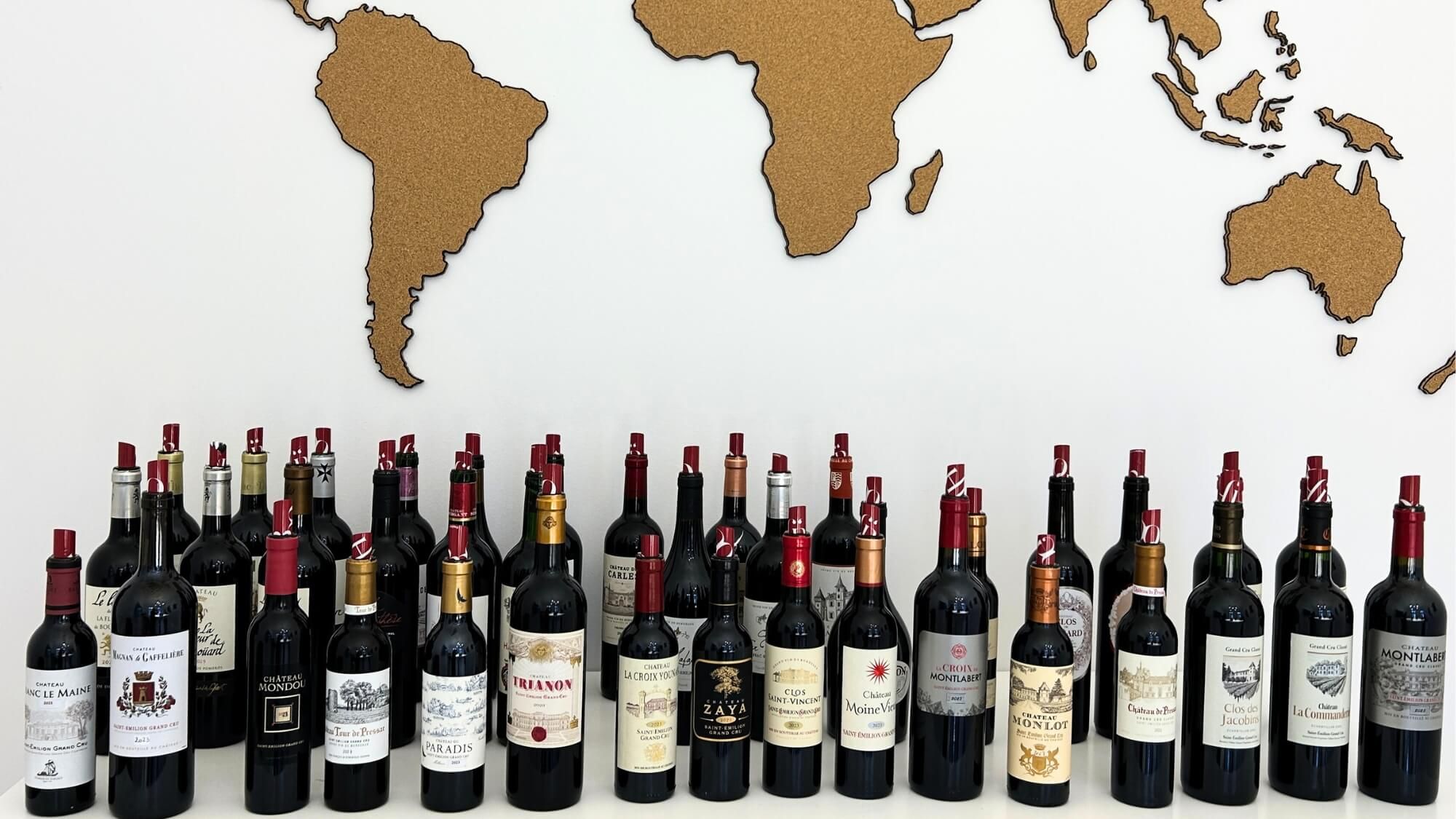AMA Tasting Report
Bordeaux 2023 En Primeur

Overall Impression
The 2023 vintage of Bordeaux wines have led me to a profound realization: one should never prematurely conclude; anything is possible.
To be frank, until mid-August, I wasn’t particularly optimistic about this vintage. From my own experiences in Bordeaux, I witnessed three months of battle against downy mildew, summers where one still needed a jacket when stepping outside; sporadic thunderstorms; grapevines laden with clusters and “plump grapes” displaying uneven “véraison”.
Yet, fortunes took a sudden turn on the second day of our son Elvin’s birth. The scorching weather from August 18th to 24th, and again from September 4th to 7th, swept away the previous gloom entirely. Maturation not only accelerated rapidly, but the grapes also successfully shed weight under the intense sunshine.
From my observations during harvest and numerous tastings of young wines, it’s evident that there is an abundance of juicy, fresh, and smooth wines. Many wines exhibit an uncommon sweetness right from the first sip, making the tasting experience delightful even at this early stage. With lower alcohol content, pronounced acidity, and fully matured polyphenols, the foundation of the 2023 vintage, “Combining Elegance and Maturity,” has been firmly established.
In my perspective, the 2023 vintage of Bordeaux embodies a “Neoclassicism” spirit. It’s termed “Classicism” for its tranquil and gentle traits that harmonize beautifully with Bordeaux’s traditional allure. But it’s labeled “Neo” because it harbors modern winemakers’ innovative techniques and philosophies.
Some estates have enhanced polyphenol maturation through improved viticultural practices, others have preserved freshness by adjusting harvest times, and still, others have highlighted floral and fruity aromas through yeast selection.
Yet, they all share a common trend: a revival of Bordeaux’s former elegance, allowing the terroir’s characteristics to be fully expressed. Even when consumed at a youthful stage, these wines offer ample freshness and charm.

In the attached section, I’ve meticulously analyzed the climatic characteristics of 2023, outlining the “5+1” Essential Conditions for a Great Vintage. Upon reading it, you’ll notice that each period of the year posed significant challenges, leaving winemakers with scarcely any respite. For smaller producers grappling with financial and human resources constraints, the pressure was particularly intense.
Based on my tastings over the past five weeks, there are significant differences in both quality and quantity. In terms of yield, some estates yielded astonishingly over 50hl/ha, while others barely reached 10hl/ha. Regarding quality, it’s been like riding a rollercoaster; neighboring estates within the same appellation could exhibit vast disparities.
Overall, while 2023 may not heralded as a “Miracle” year for Bordeaux, yet it stands as a commendable vintage of solid quality. The performance of prestigious estates has been particularly stunning, with some wines showcasing extraordinary excellence comparable to some outstanding vintages.
If you’re solely interested in recommended wines, you can directly peruse the “Blooming Lotus” wine list of Bordeaux En Primeurs 2023. However, if you seek to understand the essence of the 2023 vintage truly, I invite you to embark on an engaging and enlightening exploration journey with me.

“5+1” Essential Conditions for a Great Vintage
Pollination during the Flowering Season
Due to higher temperatures and abundant rainfall in the spring, the flowering season of 2023 started earlier than usual. By the end of May, under bright sunshine and gentle breezes, the pollination of both red and white grapes was swiftly completed within a short period, with almost no incidents of coulure and millerandage. Additionally, the potential buds left from the previous year further increased the number of flowers this year, laying a solid foundation for the high yield of the 2023 vintage.
The Condition of Grapes After Fruit Set
Continuous heavy rains in June were hardly favorable. The newly set grapes absorbed water voraciously, turning each ‘baby grape’ into a little ‘fatty’. Moreover, due to the already large number of bunches per vine, the pressure is pretty heavy. Some winegrowers even expressed astonishment as some of the typically low-yielding old vines went crazy with fruit setting in 2023. Given the large size of the initial fruits, without resorting to more “green harvesting,” it would be truly challenging to produce wine with richness and concentration.

Weather Conditions Around the Veraison Period
Although the mi-veraison in 2023 occurred earlier than the hot and dry 2022 (with mid-veraison on July 23 in 2023, compared to July 28 in 2022), the entire process was full of twists and turns. I even observed some grapes that had yet to completely change color by late August. The cool temperatures in July were largely to blame for this, significantly slowing down the grapes’ growth progress and causing uneven ripeness.
However, this weather wasn’t entirely detrimental as it helped preserve higher acidity and lower pH levels in the grapes. If the ripening could catch up later, as it did in 2023, producing wines of exceptional quality was still possible.
The Condition of Maturity
Ultimately, the 2023 vintage showed no issues with greenness, and both sugar and phenolic maturity were quite ideal, thanks in no small part to two heatwaves from August 18-24 and September 4-7. The hot weather significantly accelerated the ripening of the grapes, and the drought and strong sunlight contributed to a successful “slimming down” of the grapes by at least 10%. In some terroirs with superior natural gifts, I even observed the intensity and pleasant floral and fruity aromas typically associated with hotter vintages.

Weather Conditions During the Harvest
Different harvest timings significantly impacted the quality of the 2023 vintage. I tasted Merlot grapes from early and late September during harvest; the former often tasted hollow and bland, whereas the latter were juicier and ampler. The situation was tricky as the weather forecast predicted several rainfalls from September 10th to 20th, with a significant downpour expected around September 20th, potentially exceeding 100mm.
To pick or to wait? This dilemma troubled many winegrowers. Fortunately, only about 20mm of rain fell on September 20th, and followed by clear skies. Vineyards that harvested early rarely showed exceptional quality, while those who opted for a later harvest were likely very pleased. They could confidently extend the harvesting period, waiting for the grapes to fully ripen before picking step by step, which explains why the later-ripening Cabernet Sauvignon performed better in 2023.
Natural diseases’ Situation
The main challenge in 2023 was downy mildew, which significantly contributed to the enormous variations in quality and yield. From June to August, the pressure from downy mildew loomed over the winegrowers like the Sword of Damocles. If not sprayed at the optimal time, continuous propagation of the mildew would quickly lead to widespread infection. The impact was even more significant for vineyards employing organic and biodynamic practices, with large patches of Merlot grapes going unharvested and some vineyards yielding as little as 5hl/ha.
Château Gruaud Larose adopted a notably effective, albeit costly, approach this year. They immediately organized teams to enter the vineyards at the first sign of mildew infection on the grapes. They meticulously cut out each infected grape using small scissors, effectively preventing further infection of healthy grapes. For a biodynamic vineyard, an average yield of 41hl/ha is nothing short of miraculous.
Additionally, another detail is often ignored this year: the extreme heat in early September posed significant challenges for grapes from sandy and sandy-gravel soils, with grapes drying out not being an uncommon occurrence. Vignerons had to carefully sort and remove these dried grapes to avoid potentially harsh tannins.

The Stylistic Characteristics of Bordeaux 2023 En Primeur Wines
Red Wine
1. “Calssic Bordeaux” Revival: Crisp Acidity, Gentle Alcohol
Due to the cool and dry July, the growth rate of grapes noticeably slowed down, resulting in higher acidity levels, especially in malic acid content. The pH levels of Merlot and Cabernet Sauvignon grapes were even lower than the cool vintage like 2021, further accentuating the wines’ acidity on the palate. Additionally, the lower temperatures inhibited sugar accumulation, leading to a decrease in alcohol content by 1-2 degrees compared to warmer vintages, with most red wines ranging between 13.0% to 13.5% alcohol by volume. Clarity and gentleness define the primary characteristics of the 2023 vintage red wines. Even renowned estates like Château Montrose, Château Ducru-Beaucaillou, and Château Palmer, known for their richness, showcased the classic elegance of Bordeaux in the 2023 vintage.

2.Silky Texture with Depth, Approachable in Youth
The high temperatures in August and September, along with ideal weather conditions during the late harvest period, facilitated the complete ripening of polyphenols. Judging by the quantity of anthocyanins, the Merlot levels closely resembled those of the warm 2020 and 2015 vintages, while Cabernet Sauvignon levels were akin to the high-temperature years of 2022 and 2020. With moderate alcohol levels and fully matured polyphenols, adept extraction control by the estates could imbue a silky texture with an unexpectedly profound richness, even in wines with slender profiles. “Warm-hearted” is a frequently used term in my En Primeur wine reviews, indicating that these wines, if maintaining structural balance during aging, could be enjoyed immediately upon release.
3. “Mirroir” of “Terroir”
In hot and dry vintages, the “terroir’s profile” is often obscured by high alcohol or intense tannins, necessitating careful observation or prolonged aging for its true character to emerge. However, in vintages where alcohol levels are moderate, the body is softer, acidity is pronounced, and polyphenols are fully ripe, such as in Bordeaux 2023, it’s as if a mirror is placed in front of each wine, transparently revealing its unique terroir characteristics. For enthusiasts passionate about exploring terroir, the 2023 vintage offers an excellent opportunity to deepen their understanding of Bordeaux’s terroir without embellishment.

4. Intriguing Sweet Sensation
From the first day of En Primeur tasting, I noticed a prevalent “sweetness” in many wines, whether from the Left or Right Bank. When I refer to “sweetness” here, I don’t mean residual sugar; instead, it’s a peculiar sensation reminiscent of ripe strawberries despite the absence of actual sugar. In both Chinese and English, I haven’t found precise terminology to describe this “sweetness,” so let’s temporarily term it “Sucrosité.” Though I’m not yet certain of the origin of this “Sucrosité,” it undeniably adds a luscious fullness to the tasting experience and, to some extent, evokes a ripe and sweet sensation.
5. Wines with Issues
During the tasting, I also encountered several wines with issues. Some suffered from premature harvesting, resulting in a hollow body and lack of depth. Others exhibited impurity in aroma due to mildew exposure, while some showcased coarse tannins due to inadequate sorting of dried grapes. These issues require particular attention.

Dry White Wine
I have a particular fondness for the white wines of the 2023 vintage, as they blend the maturity of warm years with the freshness of cooler ones. Tasting them is akin to biting into a piece of snow-skin sandwich pastry, with a chewy and soft exterior, concealing a core of intense acidity. Compared to the equally outstanding 2021 vintage, the 2023 wines possess a unique roundness upon the first sip, evoking a warm-hearted and graceful atmosphere.
Mature aromas of white peach, apricot, and green mango caress the crisp citrus fragrance, enticing many to mistake it for a wine from a warm vintage based on aroma alone. However, as the velvety “snow-skin” layer gradually dissolves, the crystal-clear high acidity strikes the palate like a storm, accompanied by classic mineral notes, unleashing a tumultuous wave of flavors in the mouth.

Noble Rot Sweet Wine
I’ve awarded many high scores to noble rot wines this year, as their freshness and purity utterly enchanted me. For me, noble rot wines must exude the essence of botrytis, with dried grapes playing a supporting role without stealing the spotlight. Concentration and sugar are essential, but they must be balanced by a divine acidity that bridges heaven and earth.
The aroma must be impeccably pure, refracting a spectrum of hues like a radiant prism. It’s these qualities that define noble rot wines with soul, and thankfully, the 2023 vintage shines brightly in all these aspects.
The dry weather in late September and early October of 2023 was crucial. During this period, the proliferation of noble rot occurred rapidly, with exceptional purity. Crafting fine noble rot wines in the 2023 vintage should not be difficult if excessive residual sugar due to late harvesting is avoided.

Purchasing Tips
Given the significant differences in yield and quality in the 2023 vintage, what should we consider when purchasing, and which châteaux should we focus on? This year, I have compiled five key Purchasing Tips for you:
1.Be Cautious with Wineries Significantly Affected by Downy Mildew
The effect of downy mildew is well known, but in 2023, anyone who claimed to be unaffected by downy mildew is likely not very credible. With storms occurring almost biweekly from June to August and uneven rainfall distribution, neighboring estates might face vastly different conditions. Vignerons had to remain highly vigilant, ready to spray their fields anytime, even if it meant canceling their weekends and holidays.
However, not every winery has the financial and human resources to combat downy mildew effectively. Smaller, well-managed estates might manage to cope, but for larger estates with dozens or even hundred hectares, it is nearly impossible to spray all plots in a very short period.
2.Opt for Wineries That Perform Extensive Green Harvesting
This year, grape clusters were abundant and generally larger, necessitating more green harvesting to achieve the desired maturity and concentration. Moreover, for terroirs producing slim-bodied wines, a single round of green harvesting might not be sufficient, necessitating a second or more round. Yann Monties, the winemaker at Château La Dominique, told me they removed many grape clusters around the end of July.
Despite this, maturity was still uneven, prompting a second trimming of all lagging clusters. As a result, I witnessed unexpectedly good concentration even in terroirs not typically known for this trait. Estates like Château Brane-Cantenac, Château Calon Ségur, Château Léoville Barton, and Château Talbot benefited greatly as well from extensive green harvesting.

3.Choose Wineries Harvesting more precisely
Given this vintage’s uneven grape ripening, traditional “block harvesting” no longer meets the needs of many winegrowers. Esteemed estates such as Château Olivier, Château Beauregard, Château de Ferrand, and Château Lascombes have adopted a more precise method as “inter-row harvesting” (Sélection intra-parcellaire). Before deciding to harvest time, they isolate specific rows where grapes are not sufficiently mature, waiting to pick them until phenolic maturity is fully achieved.
Château Giscours took an even more meticulous approach by marking the ripeness of each grape cluster with different colors and then harvesting in multiple stages according to ripeness. Although it is difficult to replicate, this precision-focused method widely commands my respect.

4.Opt for Estates with Gentle Maceration Techniques
I repeat this advice every year, yet some estates continue to do the opposite. Even though the maturity is better than expected, we must acknowledge that some grape seeds were not fully mature. Over-extraction during maceration can lead to a noticeable grainy texture, even if the overall tannin levels are not high. Gentle and cold maceration are good options, and R’Pulse is an efficient and straightforward way to think about.
This year, I witnessed the application of R’Pulse at several left-bank Grand Crus Classés, including Château Lagrange, Château Kirwan, Château Brane-Cantenac, Château Lascombes, and Château Marquis d’Alesme, all of which were pleased with the results. Taking Château Kirwan as a good example, they used 100% R’Pulse maceration for the first time this year, which allowed its typically slender body to exhibit a rare richness, making it highly recommendable.
5.Wineries that Enhance Photosynthesis Smartly
While those forward-thinking wineries are rare, their practices are particularly beneficial for the 2023 vintage.
We all know that, although the accumulated temperatures were high this year, sunlight was insufficient from July to mid-August. Enhancing the efficiency of photosynthesis under such weather conditions is crucial. The approach taken by Guillaume Pouthier, the winemaker at Château Les Carmes Haut-Brion, is noteworthy. They began by leaving longer canes during winter pruning, which allowed more leaves to grow in the following spring.
Depending on the weather of each vintage, they would decide how to extend the leaf and fruit thinning. In 2023, noticing the lack of summer sunlight, they strategically preserved more leaf area to enhance photosynthesis. This attention to detail gave Château Les Carmes Haut-Brion an extraordinary maturity and aromatic complexity that surpassed many others. Not only did it maintain the same alcohol level as in 2022 (13.5%), but it also increased the proportion of whole-bunch to 60%, which is quite astonishing.

Considerations After Bottling
Given the potential issues arising after the bottling, I highlight some potential risks each year after the En Primeur tastings. This year, I would like everyone to pay attention to the following three details:
1. Whether those Extreme-elegant Wineries Could Age As Long As Before
Given the relatively gentle and elegant character of the 2023 vintage, some estates indeed left an impression of ethereal charm during En Primeur tastings. However, due to insufficient structure to support, these wines may struggle to maintain the desired depth and richness after bottling.
2. Flawlessness of Tannins
Without the aid of high maturity, flaws in the tannins can become more apparent. Some wines may show no signs of issues during barrel tastings, but whether they can maintain smooth tannins deserves special attention after bottling.
3. Impact of Acidity and pH Levels
The wines of vintage 2023 generally exhibit lower pH levels, which may indirectly enhance the perception of tannins on the palate. Particularly for some wines from limestone soils with naturally low pH values. If barrel aging is not appropriately managed, there could be an increase in astringent tannins, which could destroy the original balance of the wine.

At The End
As I conclude this year’s En Primeur tastings, I must admit the challenges I faced. Balancing the tastings with the care of my son, who still doesn’t allow us to sleep through the night, has been no small feat. My wife, Phydiasse, and I had to seize every second to work. With our usual workload of producing bilingual content, coupled with this year’s significantly early release of the En Primeur, I felt an unprecedented sense of urgency. Now, we can finally catch our breath.
I hope this meticulously crafted En Primeur report for the 2023 vintage proves to be helpful to all.
In closing, I’d like to summarize Bordeaux 2023 vintage in one sentence:
It may not be a legendary vintage, but it’s brimming with remarkable moments. It stands as a representative of Bordeaux’s “Neoclassicism,” a classic vintage that utilizes modern techniques to recreate the traditional Bordeaux spirit. Its tranquil, gentle, and pure style resonates with contemporary consumers, allowing everyone to experience the elegance and refinement of Bordeaux.

